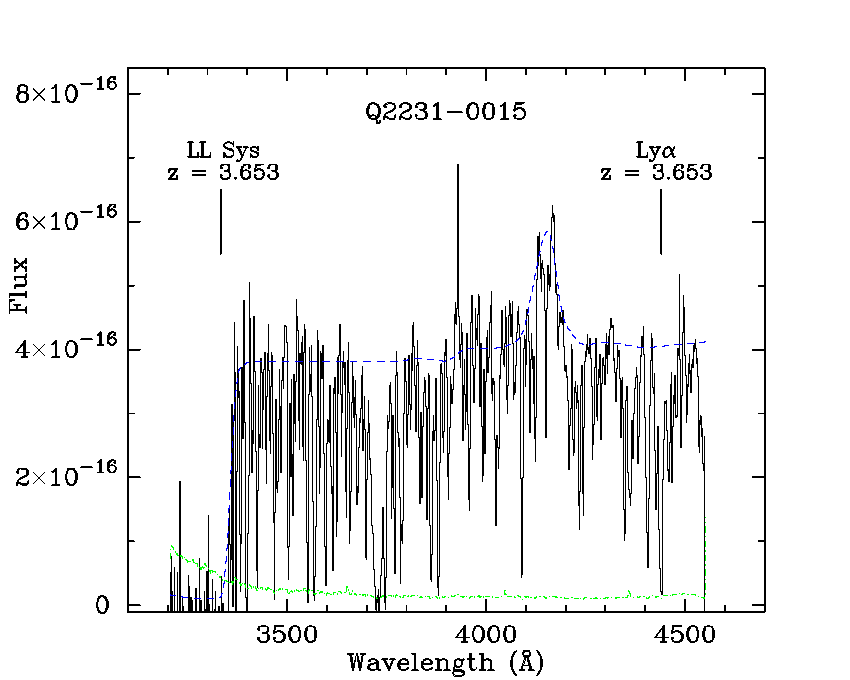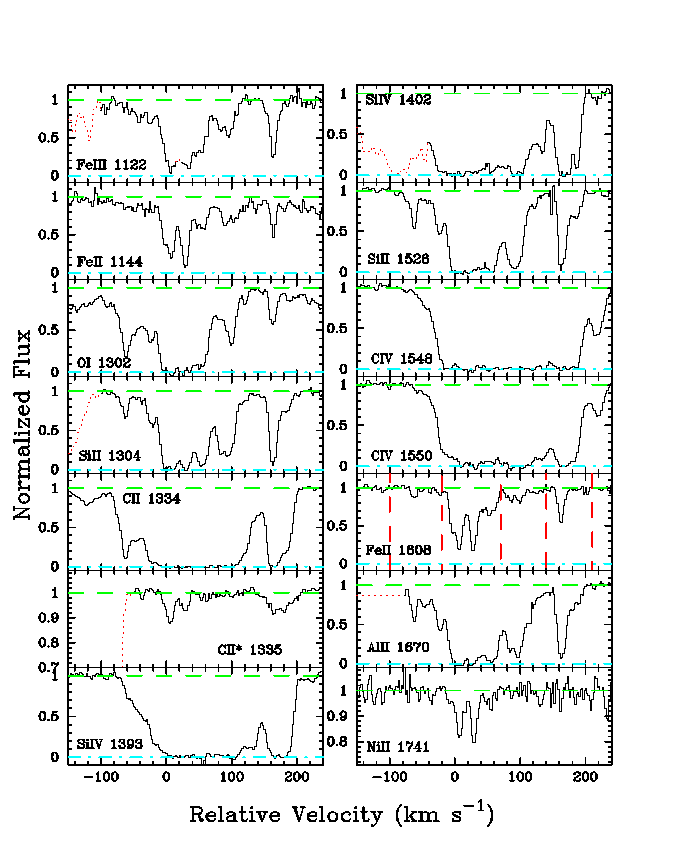The Lyman Limit Systems
 For the uninitiated, here is a fine example of a Lyman Limit system. Like
the damped Lya systems (which we all know and love)
the LL Systems are a class of QAL system. They are defined to be optically
thick at the Lyman limit, which generally implies
N(HI) > 1017 cm-2.
They all show metals, although to widely varying degree. They are probably
almost all significantly ionized, again to varying degree.
For the uninitiated, here is a fine example of a Lyman Limit system. Like
the damped Lya systems (which we all know and love)
the LL Systems are a class of QAL system. They are defined to be optically
thick at the Lyman limit, which generally implies
N(HI) > 1017 cm-2.
They all show metals, although to widely varying degree. They are probably
almost all significantly ionized, again to varying degree.
 Given the amount of time I have spent working on the
damped Lya, it isn't too surprising that I have
dabbled with the Lyman limit systems on occasion. Thus far, I have primarily
focused on the abundances of a few systems, namely those toward Q2231-00
and the HDF-S quasar. It's a tricky business because the ionization
corrections can be large. All the while, however, these systems may contain
comparable amounts of metals as the damped Lya
systems. Given how well surveyed the number density is for the Lyman
Limit systems, it is somewhat embarrassing how little else is known about
them. I expect this to change dramatically in the next few years, particularly
with the advent of large format CCD's on echelles (e.g. UVES, MIKE).
What will we learn? Who knows.. The figure on the right shows the metal-line
profiles for the LL System toward Q2231-00. If the photoionization modeling
is correct, this system has quite a high metallicity.
Given the amount of time I have spent working on the
damped Lya, it isn't too surprising that I have
dabbled with the Lyman limit systems on occasion. Thus far, I have primarily
focused on the abundances of a few systems, namely those toward Q2231-00
and the HDF-S quasar. It's a tricky business because the ionization
corrections can be large. All the while, however, these systems may contain
comparable amounts of metals as the damped Lya
systems. Given how well surveyed the number density is for the Lyman
Limit systems, it is somewhat embarrassing how little else is known about
them. I expect this to change dramatically in the next few years, particularly
with the advent of large format CCD's on echelles (e.g. UVES, MIKE).
What will we learn? Who knows.. The figure on the right shows the metal-line
profiles for the LL System toward Q2231-00. If the photoionization modeling
is correct, this system has quite a high metallicity.
Here are the two papers that I have written on the subject to date:
The Physical Nature of the Lyman Limit Systems
Prochaska 1999, ApJL, 511, L71
Investigating the Metal-Line Systems at z=1.9
Towards J2233-606 in the HDF-S; Prochaska & Burles 1999, AJ, 117, 1957
We have plenty of serendipitous 'mixed-ionization' systems along the
damped sightlines which are almost certainly LL systems.
A kinematic project is in the works and I expect some surprising
results ...
Carnegie Observatories
813 Santa Barbara St.
Pasadena, CA 91101
Phone: 626/304-0239; Fax: 626/795-8136;
e-mail: xavier@ociw.edu
modified 3/10/00